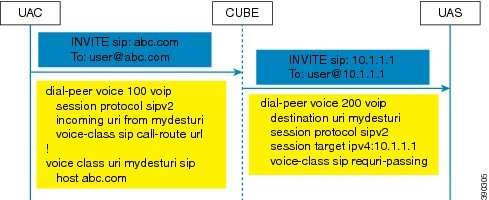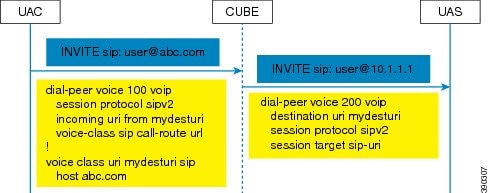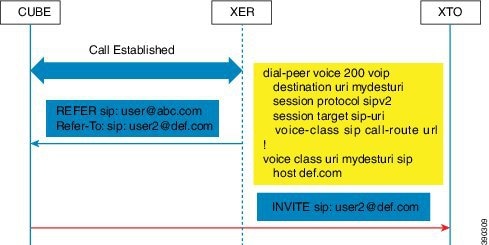- Cisco Unified Border Element Protocol-Independent Features and Setup
- Interworking Between RSVP Capable and RSVP Incapable Networks
- SIP INFO Method for DTMF Tone Generation
- WebEx Telepresence Media Support Over Single SIP Session
- DTMF Events through SIP Signaling
- Call Progress Analysis Over IP-to-IP Media Session
- Codec Preference Lists
- AAC-LD MP4A-LATM Codec Support on Cisco UBE
- Multicast Music-on-Hold Support on Cisco UBE
- Network-Based Recording
- Video Recording - Additional Configurations
- TDoS Attack Mitigation
- Cisco Unified Communications Gateway Services--Extended Media Forking
- Dynamic Payload Type Interworking for DTMF and Codec Packets for SIP-to-SIP Calls
- Acoustic Shock Protection
- Noise Reduction
- iLBC Support for SIP and H.323
- Configuring RTP Media Loopback for SIP Calls
- SIP Ability to Send a SIP Registration Message on a Border Element
- Session Refresh with Reinvites
- SIP Stack Portability
- Interworking of Secure RTP calls for SIP and H.323
- Cisco UBE Support for SRTP-RTP Internetworking
- Support for SRTP Termination
- Configuring RTCP Report Generation
- SIP SRTP Fallback to Nonsecure RTP
- Configuring Support for Interworking Between RSVP Capable and RSVP Incapable Networks
- VoIP for IPv6
- Mid-call Signaling Consumption
- Support for Software Media Termination Point
- Cisco Unified Communication Trusted Firewall Control
- Cisco Unified Communication Trusted Firewall Control-Version II
- Domain-Based Routing Support on the Cisco UBE
- URI-Based Dialing Enhancements
- Fax Detection for SIP Call and Transfer
- Finding Feature Information
- Information About URI-Based Dialing Enhancements
- How to Configure URI-Based Dialing Enhancements
- Configuration Examples for URI-Based Dialing Enhancements
- Additional References for URI-Based Dialing Enhancements
- Feature Information for URI-Based Dialing Enhancements
URI-Based Dialing Enhancements
The URI-Based Dialing Enhancements feature describes the enhancements made to Uniform Resource Identifier (URI)-based dialing on Cisco Unified Border Element (Cisco UBE) for Session Initiation Protocol (SIP) calls. The URI-Based Dialing Enhancements feature includes support for call routing on Cisco UBE when the user part of the incoming Request-URI is non-E164 (for example, INVITE sip:user@abc.com).
- Finding Feature Information
- Information About URI-Based Dialing Enhancements
- How to Configure URI-Based Dialing Enhancements
- Configuration Examples for URI-Based Dialing Enhancements
- Additional References for URI-Based Dialing Enhancements
- Feature Information for URI-Based Dialing Enhancements
Finding Feature Information
Your software release may not support all the features documented in this module. For the latest caveats and feature information, see Bug Search Tool and the release notes for your platform and software release. To find information about the features documented in this module, and to see a list of the releases in which each feature is supported, see the feature information table.
Use Cisco Feature Navigator to find information about platform support and Cisco software image support. To access Cisco Feature Navigator, go to www.cisco.com/go/cfn. An account on Cisco.com is not required.
Information About URI-Based Dialing Enhancements
Cisco Unified Communications Manager (CUCM) supports dialing using directory Uniform Resource Identifiers (URIs) for call addressing. Directory URIs follow the username@host format where the host portion is an IPv4 address or a fully qualified domain name. A directory URI is a string of characters that can be used to identify a directory number. If that directory number is assigned to a phone, CUCM can route calls to that phone using the directory URI. URI dialing is available for Session Initiation Protocol (SIP) and Signaling Connection Control Part (SCCP) endpoints that support directory URIs.
-
URI-based routing when the user part of the incoming Request-URI is non-E164 (for example, INVITE sip:user@abc.com).
-
URI-based routing when the user part is not present. The user part is an optional parameter in the URI (for example, INVITE sip:abc.com).
-
Copying the outgoing Request-URI and To header from the inbound Request-URI and To header respectively.
-
Deriving (optionally) the session target for the outbound dial peer from the host portion of the inbound URI.
-
URI-based routing for 302, Refer, and Bye Also scenarios.
-
Call hunting where the subsequent dial peer is selected based on URI.
-
Pass through of 302, with the host part of Contact: unmodified.
Call Flows for URI-Based Dialing Enhancements
Case1: URI dialing with username being E164 or non-E164 number and Request-URI host copied from the inbound leg.

Case 2: Incoming Request-URI does not contain user part. The To: header information is also copied from the peer leg when the requri-passing command is enabled.

Case 3: The old behavior of setting the outbound Request-URI to session target is retained when the requri-passing command is not enabled.

Case 4: The session target derived from the host part of the URI. The outgoing INVITE is sent to resolved IP address of the host part of the URI.

Case 5: Pass through of contact URI to request URI.

Case 6: In 302 pass-through, contact header can be passed through from one leg to another by using the contact-passing command.

Case 7: Pass through of refer-to URI to request URI.

Case 8: URI routing based on BYE Also header.

How to Configure URI-Based Dialing Enhancements
- Configuring Pass Through of SIP URI Headers
- Configuring Pass Through of 302 Contact Header
- Deriving of Session Target from URI
Configuring Pass Through of SIP URI Headers
Perform these to configure the pass through of the host part of the Request-Uniform Resource Identifier (URI) and To Session Initiation Protocol (SIP) headers. By default, Cisco Unified Border Element (Cisco UBE) sets the host part of the URI to the value configured under the session target of the outbound dial peer. For more information, see Case 1 in the "Call Flows for URI-based Dialing Enhancements" section.
- Configuring Pass Though of Request URI and To Header URI (Global Level)
- Configuring Pass Though of Request URI and To Header URI (Dial Peer Level)
Configuring Pass Though of Request URI and To Header URI (Global Level)
1.
enable
2.
configure
terminal
3.
voice
service
voip
4.
sip
5.
requri-passing
6.
end
DETAILED STEPS
Configuring Pass Though of Request URI and To Header URI (Dial Peer Level)
1.
enable
2.
configure
terminal
3.
voice
class
uri
tag
sip
4.
host
hostname-pattern
5.
exit
6.
dial-peer
voice
tag
voip
7.
session
protocol
sipv2
8.
destination
uri
tag
9.
session
target
ipv4:ip-address
10.
voice-class
sip
requri-passing
[system]
11.
end
DETAILED STEPS
Configuring Pass Through of 302 Contact Header
- Configuring Pass Through of 302 Contact Header (Global Level)
- Configuring Pass Through of 302 Contact Header (Dial Peer Level)
Configuring Pass Through of 302 Contact Header (Global Level)
1.
enable
2.
configure
terminal
3.
voice
service
voip
4.
sip
5.
contact-passing
6.
end
DETAILED STEPS
Configuring Pass Through of 302 Contact Header (Dial Peer Level)
1.
enable
2.
configure
terminal
3.
voice
class
uri
destination-tag
sip
4.
user-id
id-tag
5.
exit
6.
voice
service
voip
7.
allow-connections
sip
to
sip
8.
dial-peer
voice
tag
voip
9.
session
protocol
sipv2
10.
destination
uri
destination-tag
11.
voice-class
sip
contact-passing
12.
end
DETAILED STEPS
Deriving of Session Target from URI
Perform this task to derive the session target from the host part of the Uniform Resource Identifier (URI). The outgoing INVITE is sent to the resolved IP address of the host part of the URI. For more information, see Case 4 in the "Call Flows for URI-Based Dialing Enhancements" section.
1.
enable
2.
configure
terminal
3.
voice
class
uri
destination-tag
sip
4.
host
hostname-pattern
5.
exit
6.
dial-peer
voice
tag
voip
7.
session
protocol
sipv2
8.
destination
uri
destination-tag
9.
session
target
sip-uri
10.
exit
11.
voice
class
uri
source-tag
sip
12.
host
hostname-pattern
13.
end
DETAILED STEPS
Configuration Examples for URI-Based Dialing Enhancements
- Example: Configuring Pass Though of Request URI and To Header URI
- Example: Configuring Pass Through of 302 Contact Header
- Example: Deriving Session Target from URI
Example: Configuring Pass Though of Request URI and To Header URI
- Example: Configuring Pass Though of Request URI and To Header URI (Global Level)
- Example: Configuring Pass Though of Request URI and To Header URI (Dial Peer Level)
Example: Configuring Pass Though of Request URI and To Header URI (Global Level)
Device> enable Device# configure terminal Device(config)# voice service voip Device(conf-voi-serv)# sip Device(conf-serv-sip)# requri-passing Device(conf-serv-sip)# end
Example: Configuring Pass Though of Request URI and To Header URI (Dial Peer Level)
! Configuring URI voice class destination Device(config)# voice class uri mydesturi sip Device(config-voice-uri-class)# host xyz.com Device(config-voice-uri-class)# exit ! Configuring outbound dial peer Device(config)# dial-peer voice 13 voip Device(config-dial-peer)# session protocol sipv2 Device(config-dial-peer)# destination uri mydesturi Device(config-dial-peer)# session target ipv4:10.1.1.1 Device(config-dial-peer)# voice-class sip requri-passing system Device(config-dial-peer)# end
Example: Configuring Pass Through of 302 Contact Header
- Example: Configuring Pass Through of 302 Contact Header (Global Level)
- Example: Configuring Pass Through of 302 Contact Header (Dial Peer Level)
Example: Configuring Pass Through of 302 Contact Header (Global Level)
Device> enable Device# configure terminal Device(config)# voice service voip Device(conf-voi-serv)# sip Device(conf-serv-sip)# contact-passing Device(conf-serv-sip)# end
Example: Configuring Pass Through of 302 Contact Header (Dial Peer Level)
! Configuring URI voice class destination Device> enable Device# configure terminal Device(config)# voice class uri mydesturi sip Device(config-voice-uri-class)# user-id 5678 Device(config-voice-uri-class)# exit ! Configuring outbound dial peer Device(config)# voice service voip Device(conf-voi-serv)# allow-connections sip to sip Device(conf-voi-serv)# dial-peer voice 200 voip Device(config-dial-peer)# session protocol sipv2 Device(config-dial-peer)# destination uri mydesturi Device(config-dial-peer)# voice-class sip contact-passing Device(config-dial-peer)# end
Example: Deriving Session Target from URI
Device> enable Device# configure terminal Device(config)# voice class uri mydesturi sip Device(config-voice-uri-class)# host destination.com Device(config-voice-uri-class)# exit ! Device(config)# dial-peer voice 25 voip Device(config-dial-peer)# session protocol sipv2 Device(config-dial-peer)# destination uri mydesturi Device(config-dial-peer)# session target sip-uri Device(config-dial-peer)# exit ! Device(config)# voice class uri mysourceuri sip Device(config-voice-uri-class)# host abc.com Device(config-voice-uri-class)# end
Additional References for URI-Based Dialing Enhancements
Related Documents
| Related Topic | Document Title |
|---|---|
| Voice commands | Cisco IOS Voice Command Reference |
| Cisco IOS commands | Cisco IOS Master Command List, All Releases |
| SIP configuration tasks | SIP Configuration Guide, Cisco IOS Release 15M&T |
Technical Assistance
| Description | Link |
|---|---|
|
The Cisco Support website provides extensive online resources, including documentation and tools for troubleshooting and resolving technical issues with Cisco products and technologies. To receive security and technical information about your products, you can subscribe to various services, such as the Product Alert Tool (accessed from Field Notices), the Cisco Technical Services Newsletter, and Really Simple Syndication (RSS) Feeds. Access to most tools on the Cisco Support website requires a Cisco.com user ID and password. |
Feature Information for URI-Based Dialing Enhancements
The following table provides release information about the feature or features described in this module. This table lists only the software release that introduced support for a given feature in a given software release train. Unless noted otherwise, subsequent releases of that software release train also support that feature.
Use Cisco Feature Navigator to find information about platform support and Cisco software image support. To access Cisco Feature Navigator, go to . An account on Cisco.com is not required.|
Feature Name |
Releases |
Feature Information |
|---|---|---|
|
URI-Based Dialing Enhancements |
15.4(1)T |
The URI-Based Dialing Enhancements feature includes support for call routing on Cisco UBE when the user-part of the incoming Request-URI is non-E164 (for example, INVITE sip:user@abc.com). The following commands were introduced or modified: contact-passing, requri-passing, session target sip-uri and voice-class sip requri-passing |
 Feedback
Feedback